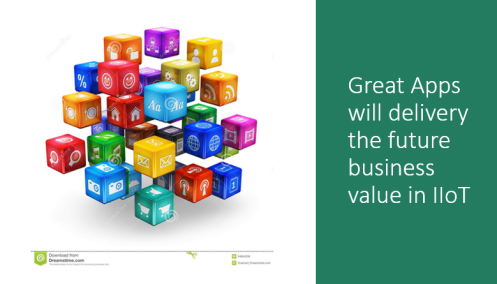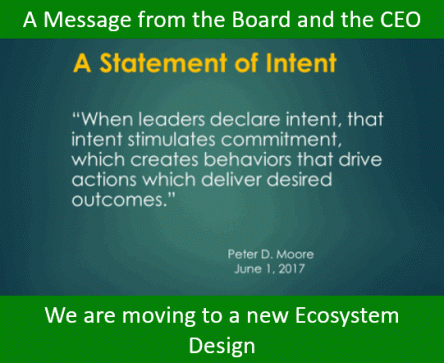 Technology is radically altering our need for innovation. We see increasingly innovation is feeding off the “digital response rate” and how we build and design the application software will transform IIoT as it has for our personal world (B2C), where we download apps on a daily basis to solve a problem or to improve our understanding.
Technology is radically altering our need for innovation. We see increasingly innovation is feeding off the “digital response rate” and how we build and design the application software will transform IIoT as it has for our personal world (B2C), where we download apps on a daily basis to solve a problem or to improve our understanding.
So what is an app? An app is a modern term for a software application, and it is most often used in reference to a mobile app or a small piece of software that runs on a website. It has made significant inroads into B2C offerings, less so on B2B. It’s typically used to describe anything that isn’t a full-fledged software program, but even that line has become blurred by those developing this apps become more creative and ta into value points for specific application. Typically apps sit on a platform and we download them or simply access them.
The capabilities of these apps vary greatly today, but some companies have started to push the boundaries of what these apps can do, turning the devices into fully functional work tools. Mobile-device management software will explode within the IIoT space. As we grow more enterprise networks the market for smart devices and/or embedded intelligence production processes will see an increase in growth. Apps will allow for a greater building out of our diagnostic needs as well as enable smart nodes. They will assist to combine experience-based knowledge with contextual automation device data and solve problems quicker as a team or send this specific data for analysis and response.
Connecting technology and innovation is altering how we should re-access organizations ability to build out. We are in the middle of a technological-led industrial revolution It is becoming highly dynamic. Apps are a critical part of the building block.
Using an app with new innovations and approaches can provide new functions by tapping into the local power of devices where tablets and smartphone operate as mini-supercomputers on site that is full of sensors, and designing specific apps to explore capabilities and rapidly “feedback” data that has potential value, often called “event management” or experience understanding.
 Ecosystems have become a really hot topic. As we gain the understanding of what a dual strategy approach to what our business could look like, you need to recognize what you still need control of, those you call your core assets. Yet at the same time, to explore and expand out more today we need to build better external collaborative approaches.
Ecosystems have become a really hot topic. As we gain the understanding of what a dual strategy approach to what our business could look like, you need to recognize what you still need control of, those you call your core assets. Yet at the same time, to explore and expand out more today we need to build better external collaborative approaches. You certainly have to make choices in life in where you focus your energy, otherwise, it gets way to complicated. For me to learn about Ecosystems and Platforms I have chosen a “select” group of IIoT players or advisors in their field to concentrate upon. Increasingly the insights and leading knowledge seems to be less coming out of the Big Consulting firms but more from those actually operating in the Industrial world (IIoT players).
You certainly have to make choices in life in where you focus your energy, otherwise, it gets way to complicated. For me to learn about Ecosystems and Platforms I have chosen a “select” group of IIoT players or advisors in their field to concentrate upon. Increasingly the insights and leading knowledge seems to be less coming out of the Big Consulting firms but more from those actually operating in the Industrial world (IIoT players). In my opening post (
In my opening post ( As I have been focusing on the Industrial platform providers like Bosch, Siemens, Schneider Electric and GE, you constantly see part of their partnership validation has been with Microsoft Azure, or Amazon and AWS or even both in some form or another. Comforting, reassuring perhaps, or is it?
As I have been focusing on the Industrial platform providers like Bosch, Siemens, Schneider Electric and GE, you constantly see part of their partnership validation has been with Microsoft Azure, or Amazon and AWS or even both in some form or another. Comforting, reassuring perhaps, or is it? IIoT platforms-as-a-service are gaining ground. In
IIoT platforms-as-a-service are gaining ground. In  I am getting fascinated by platforms and ecosystems. Does it show? This is why I am increasingly spending more time in this area as it is highly innovating in its potential.
I am getting fascinated by platforms and ecosystems. Does it show? This is why I am increasingly spending more time in this area as it is highly innovating in its potential.
 I continue to look at the world of IIoT solution platforms that are being offered to their customers which are digitally enabled, requiring connected devices to improve efficiency, productivity and increase profitability, all being provided through digital platform offerings
I continue to look at the world of IIoT solution platforms that are being offered to their customers which are digitally enabled, requiring connected devices to improve efficiency, productivity and increase profitability, all being provided through digital platform offerings